Best College & University Websites (2025) - Design That Works


Want an engaging website?
Your college’s website isn’t merely a virtual storefront; it’s a strategic platform that drives recruitment, retention, and fundraising. When designed effectively, it becomes a powerful engine for growth and engagement.
- 97% of prospective students visit a school’s website before applying—making it the most critical touchpoint in the recruitment funnel.
- 82% of prospective students say they watch videos on college websites, and 83% find those videos helpful in their decision-making process.
- 63% of prospective students have clicked on online ads from colleges, showing the growing importance of digital advertising.
- 73% use virtual tours or virtual reality experiences to explore campus before engaging with admissions.
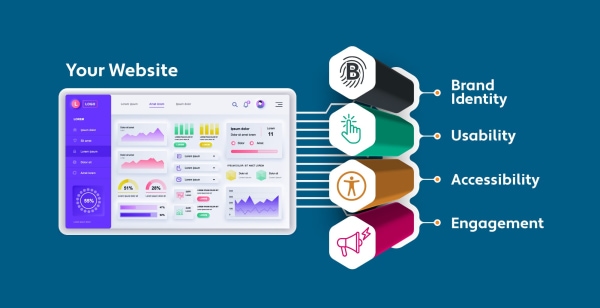
What Makes an College & University Website Design?
From attracting prospective students to inspiring alumni support, your website must excel across four essential pillars of digital strategy:
1. Brand Identity
Your website is often the first interaction a visitor has with your institution—so it must convey your mission, values, and personality instantly.
- 75% of users judge a site's credibility based on its visual design alone — including layout, typography, and color scheme.
- A Stanford study found that 94% of first impressions are related to design, not content
Your color palette, tone of voice, logo placement, and imagery should all tell the same story: who you are and why you matter.
2. Usability
A beautiful website means nothing if users can't navigate it easily. Higher ed audiences are diverse—prospective students, parents, alumni, faculty—so intuitive paths are vital.
- Users form an opinion about your site in 0.05 seconds.
- 38% of people will stop engaging if a website is unattractive or difficult to navigate (Adobe).
Usability also means performance:
- Sites should load in under 3 seconds to retain users.
- Mobile usage among college searchers exceeds 70%, so responsive design is mandatory.
3. Accessibility
Accessibility is both a legal requirement and a user experience imperative.
- Over 61 million adults in the U.S. live with a disability.
- ADA lawsuits related to website inaccessibility rose by over 23% in 2023 alone.
- Accessible websites have lower bounce rates and are better indexed by search engines.
Meeting WCAG 2.1 AA compliance ensures your site works for everyone—including screen reader users, those with vision or cognitive impairments, and people browsing on older devices.
4. Engagement
An engaging website motivates action—whether it’s applying, donating, or registering for a campus tour.
- Videos increase time on site by up to 88% and lead to 34% more conversions on landing pages.
- Story-based content (e.g., student or alumni features) builds emotional connection and trust, especially among Gen Z audiences.
- Interactive tools like virtual campus tours and financial aid calculators are used by more than 50% of students researching schools online.
Use storytelling, testimonials, dynamic content modules, and targeted CTAs to guide your audience down the right path.
In this guide, we've analyzed the top-performing college and university websites of 2025, showcasing how institutions across the U.S. and Canada are mastering these four pillars. Each example demonstrates how to integrate brand identity, usability, accessibility, and engagement into a truly effective and future-proof digital experience.
Top Picks: Best College & University Website Examples
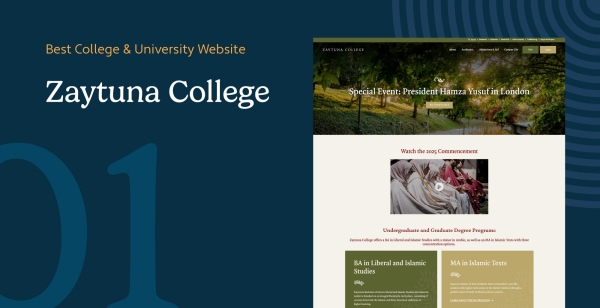
1. Zaytuna College
Berkeley, California, USA
Zaytuna College, located in Berkeley, California, is the first accredited Muslim liberal arts college in the United States. Its website reflects its commitment to intellectual tradition and holistic education through a clean, elegant design that prioritizes accessibility and engagement.
Key Features
- Academics & Admissions: The website highlights Zaytuna’s unique curriculum, blending the Islamic and Western intellectual traditions. Prospective students can seamlessly access admissions details, faculty profiles, and program offerings.
- Campus Life & Events: A well-structured events page keeps students and the broader community informed about lectures, programs, and campus happenings, reinforcing the college’s focus on engagement and lifelong learning.
- Ways to Give: Zaytuna provides multiple giving opportunities, including zakat-eligible donations, recurring gifts, and endowment contributions. A dedicated giving page simplifies the process, making it easy for supporters to contribute to the college’s mission.
With its thoughtful design, strong visual hierarchy, and intuitive user experience, Zaytuna College’s website effectively communicates its values while making information easily accessible to students, faculty, and donors alike.
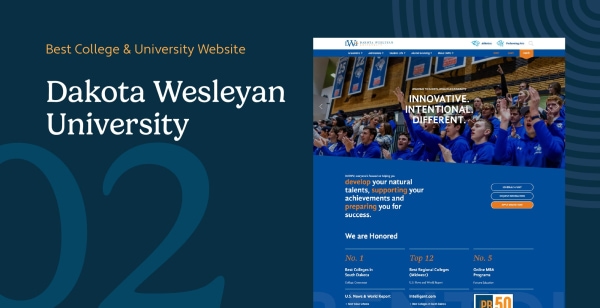
2. Dakota Wesleyan University
Mitchell, South Dakota, USA
Dakota Wesleyan University (DWU), based in Mitchell, South Dakota, reflects its faith-driven, student-centered mission through an approachable, bold website design. The color palette of blue and gold creates a vibrant, trustworthy tone while the layout balances professionalism with warmth.
Key Features
- Tailored User Pathways: The homepage features segmented pathways for prospective students, current students, and alumni. Each group is guided to relevant content, such as financial aid, course offerings, and alumni success stories.
- Storytelling Integration: Student spotlights, faculty interviews, and news snippets are woven throughout the site. These stories build emotional engagement and portray DWU as a supportive, close-knit community.
- Streamlined Giving: Their giving portal offers a clean design with options for one-time gifts, recurring donations, and legacy contributions. The process is clear and mobile-optimized, enhancing donor experience.
DWU’s website excels in using narrative content and segmented journeys to create a welcoming and action-oriented digital space for every user.
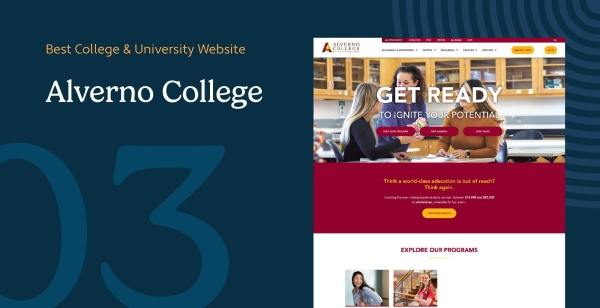
3. Alverno College
Milwaukee, Wisconsin, USA
Located in Milwaukee, Wisconsin, Alverno College is a Catholic liberal arts institution renowned for its student-centered learning model. The website serves as a highly functional recruiting tool with strategic CTAs, intuitive navigation, and a strong representation of the college’s values.
Key Features
- Visual Call-to-Actions (CTAs): The homepage prominently displays color-coded CTAs such as 'Apply Now', 'Financial Aid', and 'Virtual Tour'. These buttons help visitors quickly take meaningful action based on their needs.
- Segmented Navigation: The main menu is divided into four key areas—Academics, Apply & Afford, Campus, and Current Students. Hover menus provide specific page recommendations to improve usability.
- Data-Driven Messaging: Statistics like '100% internship and clinical placement rate' and '93% of undergraduates receive financial aid' are showcased prominently to build trust and credibility.
Alverno’s website leverages strong branding and Morweb’s CMS functionality to drive student conversions and build confidence through structured design and compelling data.
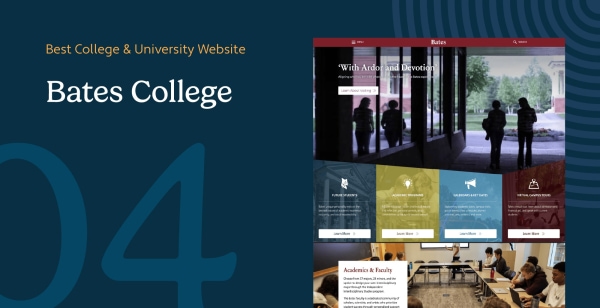
4. Bates College
Lewiston, Maine, USA
Bates College, located in Maine, offers a web experience that reflects its values of inclusivity, community, and academic rigor. The website uses open layouts and storytelling techniques to create emotional engagement with visitors.
Key Features
- Interactive Involvement Features: The homepage highlights four primary student engagement opportunities with brief descriptions and CTA buttons that direct users to learn more or take action.
- Comprehensive Fundraising Tools: The donation section includes features like recurring giving, donor-advised fund instructions, and matching gift lookup, making it easy for donors to give.
- Personalized Storytelling: Alumni and student testimonials are seamlessly woven into the design to create an authentic, mission-driven appeal.
Bates College’s website creates a compelling user journey by combining rich media, easy navigation, and giving tools that encourage deeper involvement.

5. University of Chicago
Chicago, Illinois, USA
The University of Chicago’s website combines tradition with innovation, mirroring its status as a leading research institution. Designed with both academic depth and user experience in mind, the site offers intuitive access to robust content, visually rich elements, and structured paths for different audiences.
Key Features
- Image Sliders for Immersion: The homepage features high-resolution image sliders that rotate through snapshots of campus life, student achievements, and timely news. This dynamic presentation captures attention while reinforcing the institution’s vibrancy and relevance.
- Audience-Specific Navigation: Navigation is organized by user type—Students, Faculty, Staff, Alumni, Parents, Visitors—streamlining access to targeted resources. This segmentation ensures that each visitor quickly finds content relevant to their needs, which reduces bounce rates and enhances satisfaction.
- Academic and Research Highlighting: Program pages are richly layered with multimedia, course details, and faculty bios. In addition, the website prominently features interdisciplinary research initiatives and lab profiles, appealing to prospective graduate students and academic collaborators.
- Recognition and Awards: The University of Chicago’s site has received top honors, including two prestigious Webby Awards for “Best School Website” and the “Webby People’s Voice Award.” These accolades reflect both the technical quality and user engagement the site consistently delivers.
With a clean layout, emotionally engaging imagery, and intelligent content structuring, the University of Chicago’s website exemplifies excellence in higher education web design. It balances prestige with usability and continues to serve as a digital benchmark for academic institutions globally.
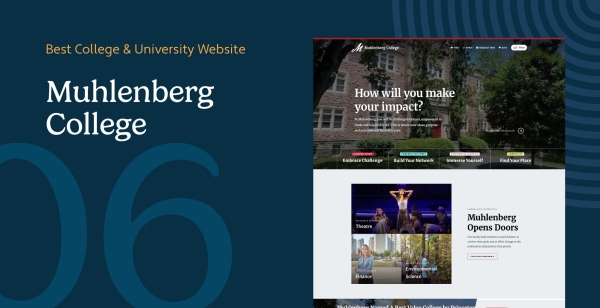
6. Muhlenberg College
Allentown, Pennsylvania, USA
Muhlenberg College in Pennsylvania communicates academic excellence and campus culture through simplicity and visual immersion. The minimalist site structure supports fast access to information while emphasizing core school values.
Key Features
- Streamlined Menus: A five-item top navigation limits overwhelm and guides users by category: About, Admissions, Academics, Student Life, and Community. Each expands into user-focused subpages.
- Dynamic Visual Content: Static images and videos showcase student experiences inside classrooms, dorms, and athletic settings, giving users an authentic glimpse into college life.
- Quick Search Tool: A search bar powered by a site-wide index helps users find targeted information without browsing through multiple layers.
Muhlenberg’s website provides a clean, no-frills design that aligns with its liberal arts focus and enhances user trust through straightforward design.
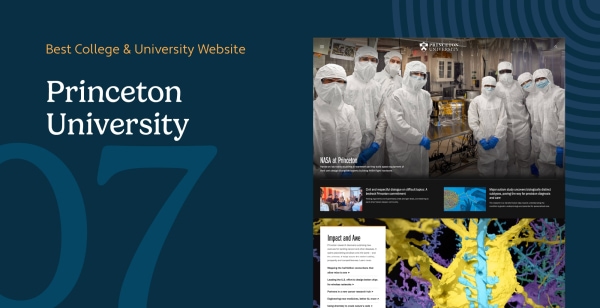
7. Princeton University
Princeton, New Jersey, USA
As an Ivy League institution, Princeton’s website maintains a minimalist design that allows its academic and research excellence to speak for itself. The user interface communicates prestige through clarity and restraint.
Key Features
- 'Meet Princeton' Microsite: The reimagined About page offers data-rich snapshots, institutional timelines, and human interest profiles, making the university’s identity both personal and prestigious.
- Extensive Footer Navigation: Links to academic calendars, social media, search tools, and directories are neatly organized at the bottom of each page, enhancing access for frequent users.
- Consistent Branding Standards: Strict adherence to font, color, and tone guidelines ensures consistency and authority across all departments and microsites.
Princeton’s website is a masterclass in brand stewardship, academic positioning, and accessibility for varied audiences—from prospective students to donors and media.
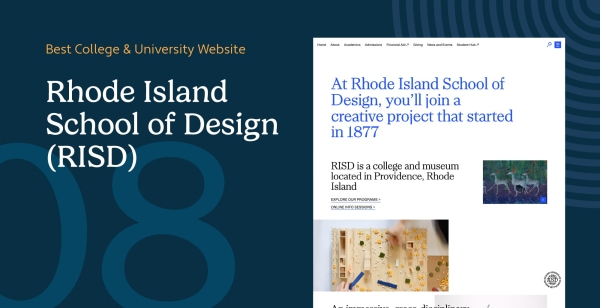
8. Rhode Island School of Design (RISD)
Providence, Rhode Island, USA
The Rhode Island School of Design (RISD) showcases creativity and academic excellence through a website that functions as both a gallery and information hub. Designed in-house, the site reflects the school’s mission to inspire the next generation of artists and designers.
Key Features
- Showcase of Student Work: Images and portfolios of current student projects are integrated across pages, immersing prospective applicants in the creative output and academic culture.
- Minimalist Design with Purpose: The use of white space draws attention to high-value content like events, admissions, and academic programs, improving information retention and UX.
- Award-Winning Aesthetics: Honored as a Webby Award nominee, the site balances design creativity with clear user flows and modern web standards.
RISD’s digital presence stands as a model for design schools, blending authenticity, functionality, and inspiration to engage artistically driven audiences.
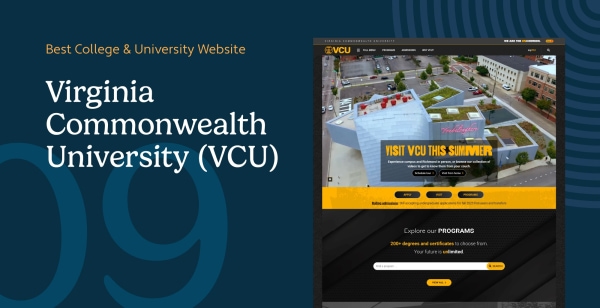
9. Virginia Commonwealth University (VCU)
Richmond, Virginia, USA
VCU’s website is a dynamic mix of ambition, research focus, and accessible design. With bold color themes and a layout designed to convert visitors, the site caters to prospective students, alumni, and partners alike.
Key Features
- Prominent CTAs: High-contrast buttons for 'Apply', 'Visit', and 'Programs' are above-the-fold, turning passive browsing into active engagement.
- Image Carousels & Video: Dynamic visuals highlight campus diversity, student success, and program depth without overwhelming users.
- Alumni & Donor Access: A separate section for alumni provides resources and updates, strengthening long-term engagement and community.
VCU’s website is bold and future-forward, leveraging smart visual design and strategic navigation to appeal across multiple stakeholder groups.

10. Howard University
Washington, DC, USA
Howard University’s website reflects the institution’s commitment to Black excellence, inclusion, and STEM advancement. With rich media and interactive features, Howard invites users into a dynamic and mission-driven campus culture.
Key Features
- Introductory Video Banner: The homepage opens with a short video montage showing students, faculty, and research activities—an emotional, inclusive welcome.
- Virtual Campus Tour: Interactive navigation helps prospective students explore facilities and learn more from wherever they are.
- Diversity Branding: The bold blue and red theme represents institutional pride while reinforcing Howard’s legacy and vision.
Howard’s site strikes a powerful balance between inspiration and information, using technology and visual narrative to attract new generations of leaders.
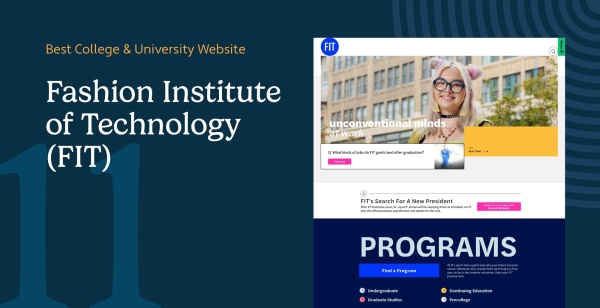
11. Fashion Institute of Technology (FIT)
New York City, New York, USA
The Fashion Institute of Technology (FIT) aligns its digital experience with its creative brand. Every element of the site—from color choice to content structure—reflects innovation, visual storytelling, and user-centered design.
Key Features
- Vibrant Visual Language: The homepage resembles a collage, using energetic yellow, pink, and blue accents and bold visuals to mirror the energy of student life.
- Complete Program Index: Prospective students can browse every program in one scrollable interface, categorized by degree type and industry.
- Creative Authenticity: Photography and video spotlights real students, faculty, and projects in the design, business, and tech space.
FIT’s website showcases the power of aligning design with brand identity, creating an interactive experience that informs and inspires future creative professionals.
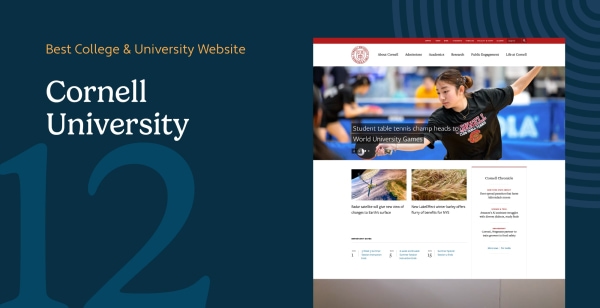
12. Cornell University
Ithaca, New York, USA
Cornell University’s website blends elite academic credibility with high-impact storytelling and a strong focus on accessibility. Located in Ithaca, New York, the site showcases academic rigor, community, and campus beauty in equal measure.
Key Features
- Research Focus: Cornell dedicates an entire section to current research initiatives, featuring multimedia case studies and lab profiles that underscore the school’s contribution to innovation.
- Live Campus View: A webcam on the homepage offers real-time visuals of the central campus, emphasizing the school's connection to nature and day-to-day campus life.
- Accessibility Commitment: Clear navigation, high-contrast design, and an accessibility contact statement ensure inclusive access for all users.
Cornell’s web experience delivers an ideal mix of scholarly impact and emotional appeal—essential for converting top-tier applicants and supporting institutional transparency.

13. Georgetown University
Washington, DC, USA
Georgetown’s website reflects its legacy as an international Catholic and Jesuit institution. It combines deep history with a user-first approach and clearly segmented resources.
Key Features
- Audience Segmentation: Students, faculty, alumni, and prospective enrollees all have tailored access paths from the navigation menu, streamlining the user experience.
- Institutional Storytelling: The website includes robust historical archives and statistics that demonstrate Georgetown’s impact in healthcare, law, and diplomacy.
- Comprehensive Navigation: A multi-layered menu and content filters allow users to browse research, degrees, events, and admissions pathways without friction.
Georgetown University uses clear segmentation and authoritative messaging to build trust and offer a seamless journey across diverse audience needs.
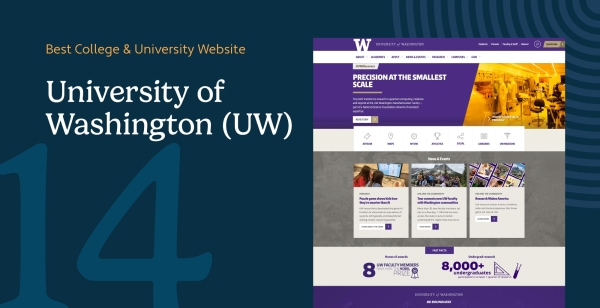
14. University of Washington (UW)
Seattle, Washington, USA
As one of the largest public universities in the U.S., UW's website is bold, structured, and inclusive. Its navigation hierarchy and donation UX are standout features.
Key Features
- Streamlined Donation Funnel: UW’s giving page breaks down the donation process into three steps, offering suggested amounts, impact areas, and contactless payment options.
- Icon-Based Navigation: Visitors are guided through visual icons to explore athletics, maps, campus tours, and social media—supporting different learning styles.
- Social Integration: The site integrates live social feeds and student videos to keep content fresh and community-focused.
With a blend of practical design and community energy, UW’s site fosters engagement from prospective students to lifelong alumni supporters.
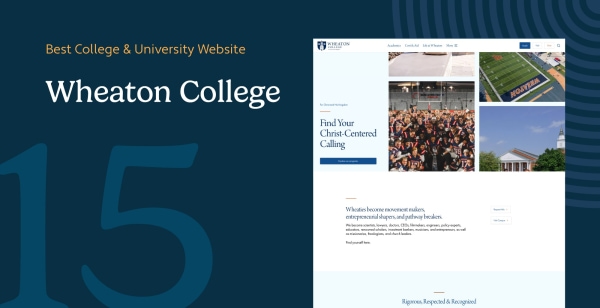
15. Wheaton College
Wheaton, Illinois, USA
Wheaton College’s website offers a personal and community-driven experience. It places a strong emphasis on student voices and Christian liberal arts values.
Key Features
- Student-Driven Blog: A dedicated blog captures campus life through articles written by students and staff, offering insight into academic and spiritual life.
- Social & Testimonial Feeds: Instagram and video testimonials are embedded across pages, giving visitors a feel for campus community before even visiting.
- Event-Focused UX: An accessible calendar includes student recitals, lectures, and athletics, helping foster engagement even from first-time visitors.
Wheaton’s website fosters belonging and trust, using firsthand stories and visual warmth to welcome potential students into its close-knit culture.
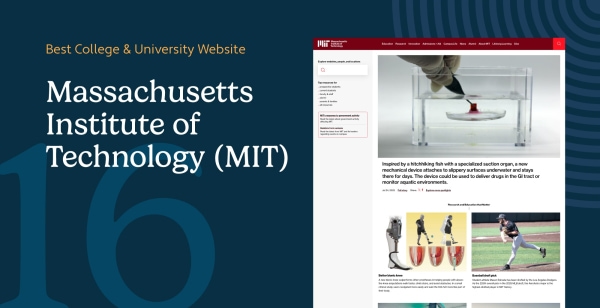
16. Massachusetts Institute of Technology (MIT)
Cambridge, Massachusetts, USA
MIT’s website reinforces its reputation as a global leader in science and engineering. The digital design is data-rich, modern, and centered on innovation.
Key Features
- Unconventional Layout: A static vertical navigation bar on the left gives space to an auto-scrolling feed of news and breakthroughs, maintaining continuous engagement.
- Content-Driven UX: Rather than relying solely on visuals, the homepage features rich academic content—research briefs, student interviews, and department links.
- Accessibility & Caution: Though creative, the unconventional structure may be challenging for mobile users or screen readers, highlighting the need for alternative navigation support.
MIT’s site successfully mirrors its campus: technologically advanced, highly intellectual, and built for discovery—but may require refinement to maximize accessibility.
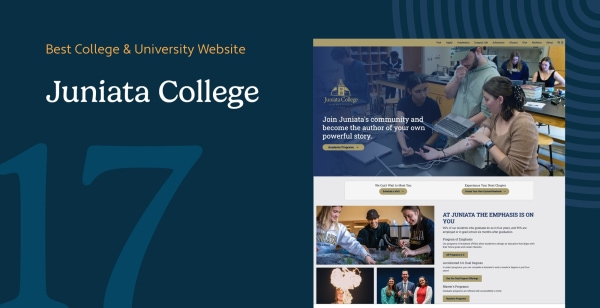
17. Juniata College
Huntingdon, Pennsylvania, USA
Juniata’s website stands out for its narrative approach. It uses human-centered storytelling and motivational language to build emotional connection.
Key Features
- Conversational Homepage: With headlines like 'Become the Author of Your Own Powerful Story', the homepage invites personal reflection and direct interaction.
- Student & Alumni Profiles: Real-life success stories take center stage, building credibility through authenticity and shared experience.
- Interactive Calls-to-Action: Prompts to explore, visit, or apply are written in empowering language that reflects Juniata’s community-driven mission.
The Juniata website creates a deep emotional connection, establishing a sense of belonging and inspiration that helps convert curious visitors into applicants.
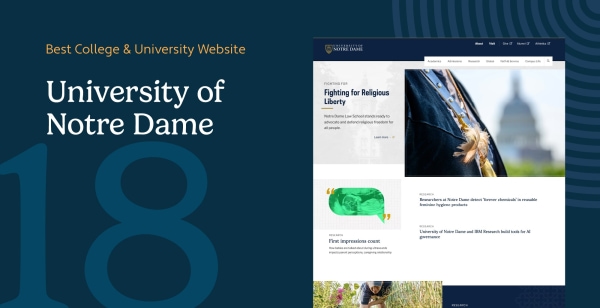
18. University of Notre Dame
Notre Dame, Indiana, USA
Notre Dame’s website is traditional and polished, aligning with its heritage and academic brand. It incorporates responsive design and branding best practices.
Key Features
- Strict Branding Consistency: Every page adheres to defined design standards for colors, typefaces, and layout—preserving credibility and identity across departments.
- Mobile Optimization: Design elements seamlessly adapt to different screen sizes, ensuring that both prospective students and alumni have an excellent experience on all devices.
- Photographic Storytelling: High-resolution photography tells the story of campus life, student activities, and institutional pride.
Notre Dame’s web presence is a premium example of legacy branding and responsive functionality merged for maximum trust and user satisfaction.
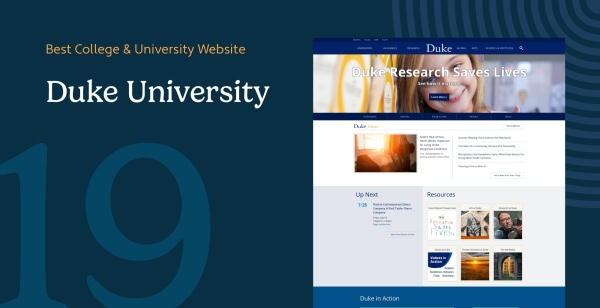
19. Duke University
Durham, North Carolina, USA
Duke University’s site is accessible, well-organized, and built for impact—supporting enrollment, donor engagement, and academic reputation all at once.
Key Features
- Audience-Tailored Menus: Navigation anticipates user intent with clearly labeled tabs for prospective students, alumni, and researchers.
- Donor-Focused Design: The 'Giving to Duke' section emphasizes transparency and outcome-driven philanthropy, using testimonials and visuals to motivate support.
- Visual Flow: Strong layout hierarchy, iconography, and whitespace help streamline decision-making for new users.
Duke combines design elegance with functional clarity, supporting a full-funnel strategy for applicants, donors, and institutional partnerships.
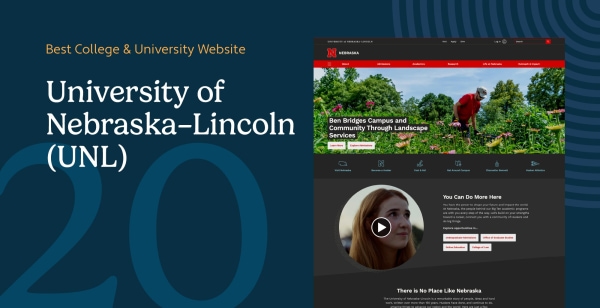
20. University of Nebraska–Lincoln (UNL)
Lincoln, Nebraska, USA
UNL’s website exemplifies digital simplicity done well. It is visually clean and action-oriented, emphasizing navigation clarity and usability.
Key Features
- Segmented Navigation by Audience: The menu is sorted into user types (prospective students, faculty, etc.), each receiving focused content paths.
- Strategic Use of White Space: Negative space helps isolate important actions like applying or giving, increasing engagement through clean contrast.
- Efficient Search Tool: An intuitive site-wide search bar ensures that even niche queries can be addressed quickly and effectively.
UNL’s website is a great example of how minimalist design and smart segmentation improve usability and foster meaningful engagement.

21. Stanford University
Stanford, California, USA
Stanford’s site is built around its research leadership, academic depth, and global community. It serves as both a marketing hub and informational gateway.
Key Features
- School-Based Navigation: Users can easily explore specific academic schools (e.g., Law, Medicine, Engineering) through distinct microsites.
- Blogroll & News Integration: High-visibility news updates and features humanize Stanford’s achievements while keeping the homepage dynamic.
- Campus Imagery: Photo galleries and embedded video highlight student life, sustainability efforts, and international reach.
Stanford’s site is a benchmark for how a global academic institution can scale design, content, and technical performance in one seamless digital experience.
Bonus: How to Improve Your Existing College Website
Just as no two institutions are the same, your website should reflect your college’s unique mission, community, and culture. After exploring top-performing college websites, you now have a blueprint—but the real challenge is adapting best practices to fit your brand and your audience.
Whether you're revamping an outdated site or optimizing a current one, the following strategies can elevate performance, engagement, and credibility.

1. Leverage SEO to Drive Organic Traffic
93% of online experiences begin with a search engine. Google processes over 40,000 search queries per second, and higher ed search intent is on the rise.
To stand out:
- Target keywords like “best liberal arts college in [State]” or “online nursing degree program”
- Use descriptive, keyword-rich meta titles and descriptions
- Optimize images (filename, alt text, compression)
- Implement schema markup for events, faculty, and FAQs to appear in rich snippets
Tools like Morweb’s built-in SEO module make this process easier by enabling custom URLs, automatic sitemap generation, and metadata configuration—all without code.
2. Showcase Faculty with Searchable Directories
52% of prospective students say that faculty credentials influence their application decision.
Use a faculty directory to humanize your institution and highlight its academic strength:
- Include professor bios, academic credentials, course history, and research interests
- Add filters by department, degree, or program
- Include headshots and office hours for increased accessibility
Morweb’s Teachers Directory Module makes it easy to manage and update profiles institution-wide.
3. Tap Into Google Ads and the $10K Ad Grant
1 in 3 students discovers a school through paid digital advertising. If your institution has a 501(c)(3) fundraising arm, you may qualify for the Google Ad Grant, which offers $10,000/month in ad credits for search campaigns.
Key campaign goals might include:
- Driving traffic to your “Apply Now” or “Visit Campus” page
- Promoting specific programs (e.g., Nursing, MBA, Theology)
- Raising awareness about scholarship or financial aid deadlines
Tip: Google Ad Grant eligibility can be tricky—partner with a certified grant agency to ensure compliance and maximize impact.

4. Use Donor and Student Engagement Tools
Institutions that use digital stewardship tools see a 26% increase in repeat donations.
Don’t just collect support—build community:
- Add digital eCards for donors to share their impact
- Let students send appreciation notes to peers, professors, or parents
- Create automated “thank you” pages and email sequences after donations or applications
These emotional touchpoints can build stronger relationships and improve donor retention.
5. Track, Measure, Optimize
The average higher end site has a bounce rate of 52%—but that can drop below 35% with performance-based optimization.
Key metrics to monitor:
- New vs. Returning Visitors – Are your campaigns attracting new traffic?
- Donation Conversion Rate – Are donors following through?
- Time on Page – Are visitors engaging with content or bouncing quickly?
- Click-through on CTAs – Are users taking action or getting stuck?
Use Google Analytics 4 or integrated CMS dashboards to establish baselines and measure growth over time.
Improving your college website doesn’t mean starting from scratch. By implementing a smart SEO foundation, promoting your faculty, activating digital campaigns, and enhancing the user experience, your site can become a true asset for marketing, enrollment, and fundraising.
Remember: A good website doesn’t just inform—it inspires.